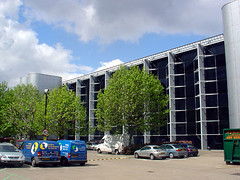| The Roman Baths (Thermae) of Bath Spa, England. This is a 6 segment panorama taken by myself with a Canon 5D and 24-105mm f/4L IS lens. (Photo credit: Wikipedia) |
Bath is located in the northern tip of the ceremonial county of Somerset near the border with Wiltshire and just 13 miles from the important trade port and cultural centre of Bristol; but it is its position in the valley of the River Avon, right on the edge of the Cotswolds that is the reason for its existence as it is the site of the hottest natural geothermal springs in the UK.
The establishment of Bath and its subsequent prosperity throughout the ages can be traced back to the discovery of these three hot springs. From prehistoric times the site was important as a place of worship with people investing the springs’ waters with healing powers whilst honouring the pagan god Sulis. With the arrival of the Romans in AD40 the new town of Aqua Sulis sprung into life and the spiritual importance of the springs was embraced. They were the first to build permanent stone structures around the springs, from 60-70AD onwards, channeling the naturally warm waters into classic Roman bath rooms. In doing so they began the site’s transition into a prosperous spa town and a destination where travellers would come from far and wide searching for the healing properties of the waters.
The unique spa and baths meant that the city remained a popular destination for the great and good of society throughout the near history from Elizabethan to Georgian to Victorian times - bringing to the town a rich mix of culture and high society living which lives on today in its traditions of theatre, music and the arts.
The Baths
Whilst we may no longer assign such spiritual significance to the springs, the baths are still a draw for visitors who still come to take advantage of their perceived healing or, at least, relaxing powers. The Roman Baths themselves have been rebuilt, along with much of the city, during Georgian period and in the classical and Palladian styles although some of the original buildings have been preserved. The complex now consists of the Sacred Spring, the Roman Temple, the Roman Bath House and a museum, and although they are no longer used for bathing, they are a fascinating historical attraction to be toured, providing a great insight into the history and the heart of the city.
For those wanting to take a dip in the famous waters, the new bath complex, the Thermae Bath Spa, was opened in 2006 with the New Royal Bath at its heart, featuring two spring fed baths, an open top pool with views of the city centre and extensive spa facilities. It also incorporates the older Hot Baths and the open Cross Bath which were again rebuilt by the Georgians but can still be used for bathing nowadays.
Bath Abbey
Adjacent to the Roman Baths is Bath Abbey. The abbey was first founded as a monastery by the Anglo Saxons and has been rebuilt by successive Bishops of Bath & Wells starting shortly after the Norman conquest and finishing with a major rebuild in the Elizabethan period. For a time in the middle ages it served as the seat for the Bishops of Bath and Wells and it is an excellent example of gothic architecture, particularly noted for its fan vaulted ceiling.
Georgian Architecture
The popularity of Bath during the Georgian era led to great expansion and left us with the famous and distinctive architecture associated with the city today. Built using the distinctive bath stone - limestone from surrounding hills - much of the Georgian architecture was designed by father and son John Wood the Elder an John Wood the Younger in a classical revival and Palladian style. The most notable examples of the period are the majestic Royal Crescent and the unique Circus (some of the most sought after addresses in the country), although the architecture also continues through many of the adjoining streets spreading west from the city centre. The layout of the Georgian streets and the ornate decorations on the building themselves are said to contain nods to masonic and occult references and it is thought, for example, that the layout of the Circus, Gay Street and Victoria Square represent a masonic key symbol.
Bath is also home to Pulteney Bridge situated on the River Avon. Again it is constructed in the Georgian style whilst being influenced by bridges such as the Ponte Vecchio in Florence. It is one of only four bridges in the world to carry shops.
Shopping
Bath is now a major shopping centre catering for tourists and locals alike. It has a healthy mix of high street names, particularly in the new shopping area of SouthGate, high end boutique shops (Milsom Street) and quirky independent shops in the back streets and alleys leading away from the Abbey. The city also has plenty of eateries dotted about the town centre from leading Vegetarian restaurants to the famous Sally Lunns bakery and cafe which is seen as the home of the Bath bun.
For thousands of years, Bath has been a popular destination for travellers and tourists still come from across the world to stay in the unique city. Whether you want to take in the splendour of the Georgian streets, take a relaxing dip in the thermal waters or simply do a bit of Christmas shopping, Bath has plenty to offer.
© Stuart Mitchell 2011
If you are looking for legal assistance in Bath then visit Solicitors Bath.














